Duoro Valley Day Trip from Porto: Is It Worth It?
Disclaimer: This post may contain affiliate links, which means I may earn a small commission if you make a purchase at no additional cost to you. I only recommend products and services that I would use myself and all opinions expressed here are my own. You can read my full privacy policy here.
I spent five weeks in Porto and kept hearing about the Douro Valley. Everyone said I had to go. So when my friend visited from London, I finally booked a full-day Douro Valley wine tour through GetYourGuide.
The trip left at 8am from central Porto. We were picked up in an air-conditioned coach – and honestly, the air conditioning was necessary because by 10am when we reached the valley, it was already noticeably hotter than Porto.
About This Guide
I visited Porto for 5 weeks in August 2025 (my third visit to the city), staying in four different neighborhoods. This guide is based on my firsthand experience taking a full-day Douro Valley tour in peak summer, combined with research on alternative tour options and DIY approaches.
Table of Contents
What Actually Happens on a Douro Valley Day Trip
Quick Answer – Is Duoro Valley Worth a Visit?
Yes, absolutely. I took a Douro Valley day trip in August 2025 and it was one of the best experiences of my Porto visit. The vineyard views are stunning, the wine tastings are generous, and the boat cruise is peaceful. Just know it is 5 degrees hotter than Porto due to the microclimate, so dress accordingly. Expect to pay around 85-95 euros for a full-day tour with lunch, tastings, and boat cruise included.
Most Douro Valley tours from Porto follow a similar structure. You leave Porto early (usually 8-9am), drive about 90 minutes into the valley, and spend the day visiting 2-3 wineries, having lunch, and taking a boat cruise on the Douro River.
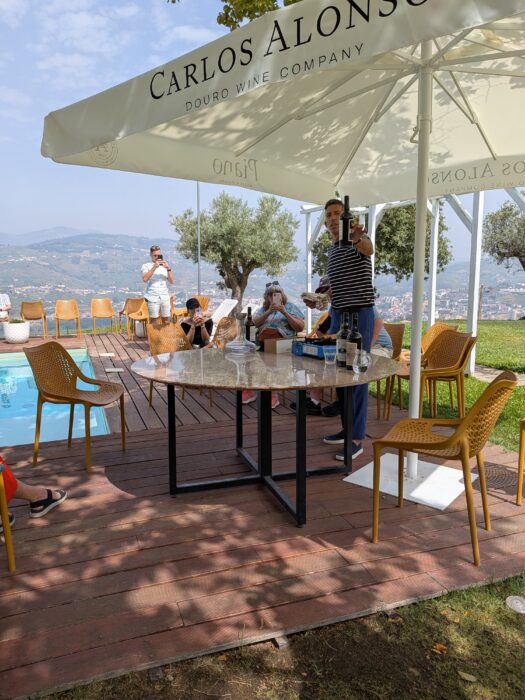
Our tour had three main stops. The first was my favorite – a family-owned vineyard perched on a hillside with views that stretched for miles. Rows and rows of grapevines on terraced slopes. We did a short walking tour through the vineyards where our guide explained the different grape varieties grown there.
Then came the tasting. We tried four ports: a white port, a tawny, a ruby, and a vintage. The guide was generous with the pours. By the third glass, people were definitely getting tipsy.
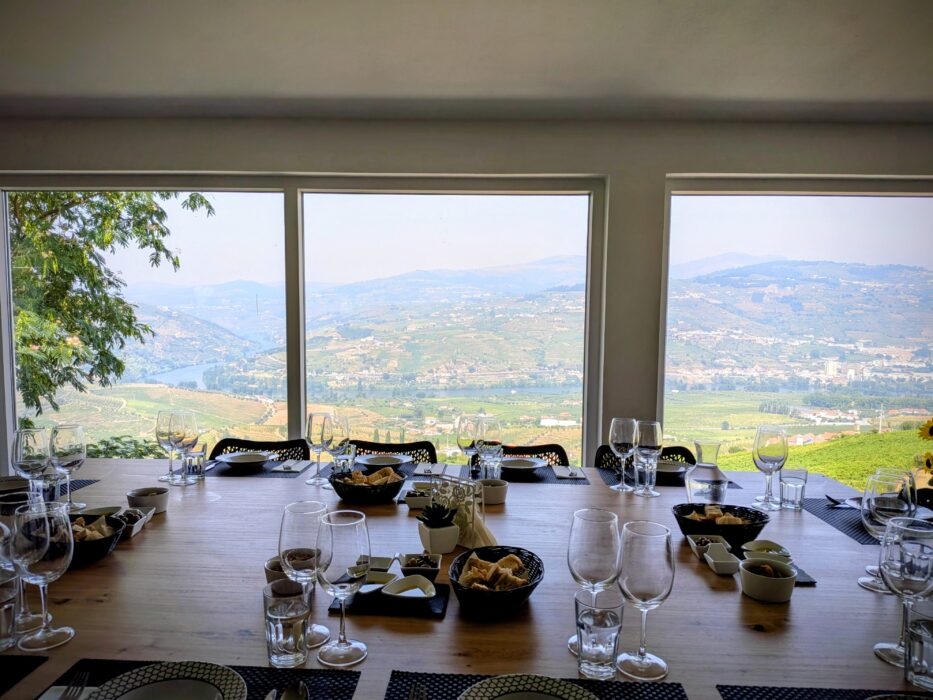
The Farm-to-Table Lunch
Lunch was served at the same vineyard. It was a proper sit-down meal – not a rushed buffet situation. We had traditional Portuguese dishes: bacalhau (salt cod), roasted vegetables, local cheeses, fresh bread, and wine. Lots of wine. The meal alone probably would have cost 25-30 euros at a Porto restaurant.
I am cheap, so I always calculate whether tours are worth it. The lunch, combined with the wine tastings and transportation, already justified most of the 89 euro tour price.
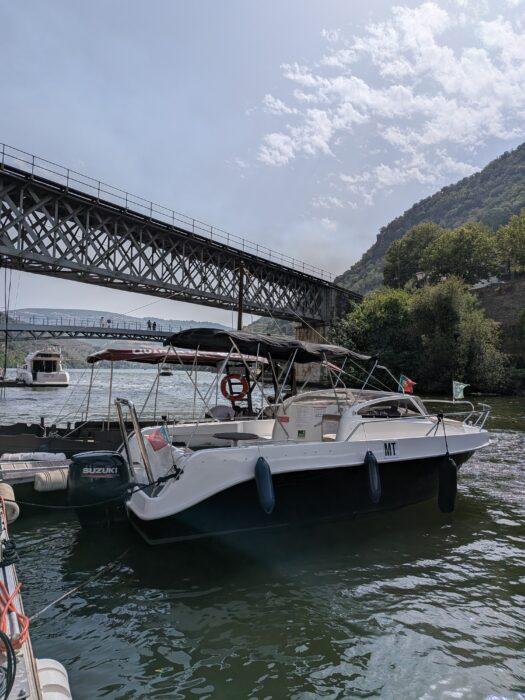
The Douro River Boat Cruise
After lunch, we were split into four smaller groups and taken on traditional rabelo boats for a river cruise. These are the flat-bottomed boats that historically transported port wine barrels down the river.
The cruise lasted about an hour. We floated down the Douro River, passing more vineyards on both banks. Our guide kept topping up glasses with sparkling wine. This is where a lot of people got properly drunk. I stopped counting after the fourth refill.
The boat cruise was relaxing. Gentle river, warm sun, slight breeze. No loud music or party atmosphere – just peaceful views and wine. I actually fell asleep for about 15 minutes.
The Third Stop: Family Owned Winery focused on innovation
Our final stop was a larger, more commercial winery. The son of the founder had recently taken ownership of this place and made it more accessible for visitors, opening it up for tours for the very first time recently.
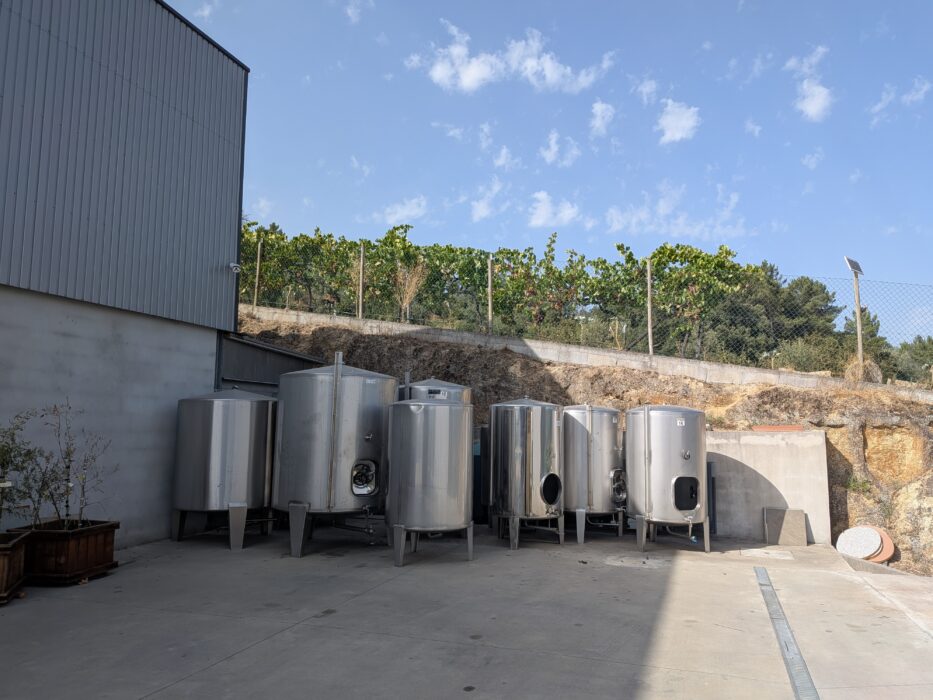
We walked through the production facilities and aging cellars. They had massive oak barrels – some over 100 years old – stacked in temperature-controlled rooms.
Another tasting here. Three more ports, plus cheese and crackers. By this point, I was completely over sweet port. I could not drink any more. But the cheese was excellent, and I appreciated being able to sit in the cool cellar after being in the sun all day.
We got back to Porto around 6:30pm. Long day, but I did not feel rushed at any point.

The Microclimate Situation – Seriously, It Is Hot
Here is something I wish I had known before booking: the Douro Valley has its own microclimate. It is consistently 5 degrees Celsius hotter than Porto. Sometimes more.
Porto in August was already warm – around 25-28°C most days. But the Douro Valley? It hit 33°C the day we went. That is nearly 92°F.
I wore a light sundress and sandals, which was fine. But several people on our tour were in jeans and closed shoes. They suffered. The valley has very little shade – it is all open hillsides and vineyards. Bring a hat, wear sunscreen, and dress for serious heat if you go in summer.
Money Saver
Book your tour at least 2-3 weeks in advance. Prices go up as availability decreases, especially in July-August. I paid 89 euros booking 3 weeks out. The same tour was 105 euros when I checked availability the week before.
Douro Valley Day Trip vs DIY: Cost Comparison
I researched doing the Douro Valley independently before booking a tour. Here is what it would cost:
DIY Option:
- Train from Porto to Pinhão: 12 euros each way = 24 euros
- Winery tour booking (1-2 wineries): 20-35 euros per person
- Lunch at a valley restaurant: 20-30 euros
- Local transport between wineries (taxi or arranged transfer): 20-40 euros
- Total: 84-129 euros
Guided Tour Option:
- Full-day tour with hotel pickup: 85-95 euros
- Includes: Transport, 2-3 winery visits, all tastings, lunch, boat cruise, guide
- Total: 85-95 euros
The guided tour is actually cheaper or the same price as going independently, plus you do not have to coordinate anything or worry about transport between wineries. And you can drink as much as you want without worrying about driving.
The Portuguese train system (CP) does run a scenic train route through the Douro Valley, which takes about 2 hours from Porto to Pinhão. The train follows the river and the views are supposed to be beautiful. But once you arrive in Pinhão, you still need to arrange winery visits and transport, which gets complicated without a car.
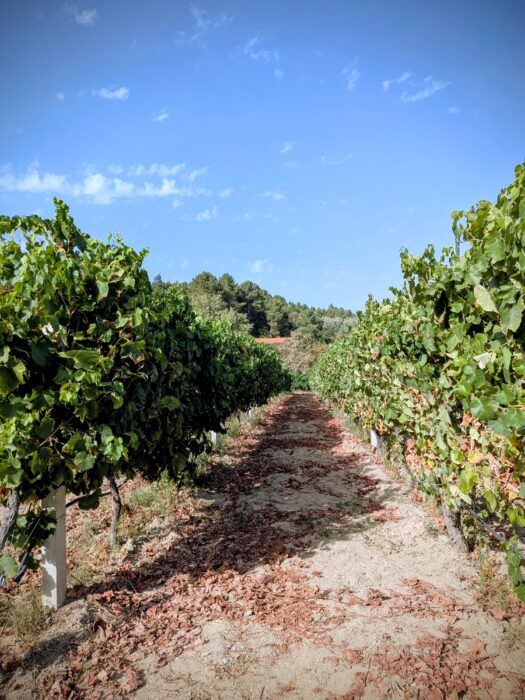
Best Douro Valley Tours from Porto (2025)
I compared about eight different Douro Valley day tours before booking. They are all pretty similar in structure, but here are the key differences:
Recommended Douro Valley Day Tours
- Douro Valley with Boat Tour, Wine Tasting & Lunch – 89 euros
– 4.7/5 (2,400+ reviews) – Full-day tour, 2 wineries, traditional lunch, 1-hour boat cruise, air-conditioned transport - Small-Group Douro Tour (Max 8 People) – 95 euros
– 4.8/5 (890 reviews) – Boutique wineries, smaller groups, personalized experience, same inclusions - Douro Valley with Chef’s Lunch & 11 Wine Tastings – 105 euros
– 4.9/5 (1,200 reviews) – Premium experience, farm-to-table lunch, more tastings, family-owned wineries
Small Group vs Large Coach Tours
I took a large coach tour (about 45 people). It was fine. We were split into smaller groups at each winery, so it never felt too crowded. Lunch seating was a bit chaotic – people scrambling for tables – but manageable.
Small group tours (8-15 people) cost about 10-20 euros more. You get more interaction with the guide, more flexibility with timing, and a more personalized experience. If you care about that, it is worth the extra cost. If you just want to see vineyards, taste wine, and have lunch, the large coach tours are perfectly adequate.
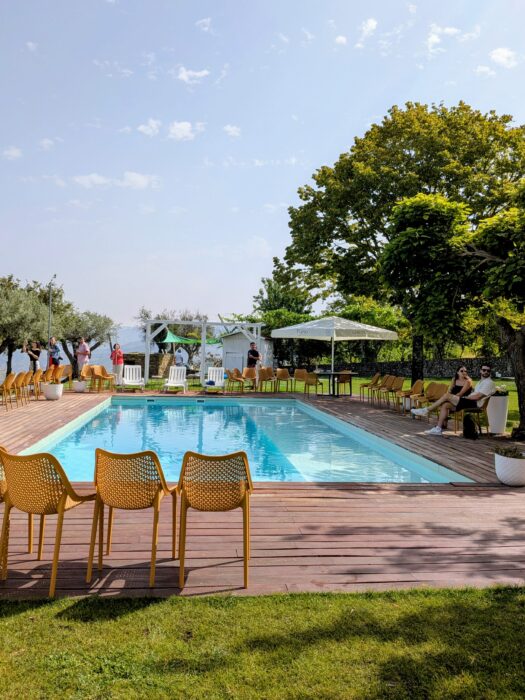
What to Bring on a Douro Valley Day Trip
Based on what I brought (and what I wish I had brought):
Essential:
- Sunscreen – reapply at lunch
- Hat or cap – there is almost no shade
- Sunglasses
- Water bottle – they provide water on the bus but bring your own just in case
- Light, breathable clothing – it is 5 degrees hotter than Porto
- Comfortable walking shoes – you will walk through vineyards, which can be uneven terrain
Recommended:
- Small backpack or crossbody bag
- Phone charger or portable battery – you will take a lot of photos
- Cash – some wineries sell bottles and only take cash
- Light jacket for the bus ride back – air conditioning can be cold after a hot day
Do Not Bring:
- Large bags or suitcases – nowhere to store them
- Heels or fancy shoes – vineyards are not paved
- Heavy makeup – you will sweat it off
Best Time to Visit the Douro Valley
I went in August, which is peak tourist season. The valley was busy but not unbearably crowded. The advantage of August is that the grapevines are fully grown and green, creating those iconic terraced hillside views.
September is harvest season, which would be fascinating to see. Some tours in September include grape stomping experiences. It is also slightly cooler than August but still warm.
Spring (April-May) is less crowded and cooler, but the vines are not as lush. The landscapes are still beautiful – just different.
Winter (November-February) is the cheapest time to visit. Tours run less frequently, and some smaller wineries close. But if you care more about port tasting than vineyard views, winter works fine. Just bring warmer clothes – it can be cold and rainy.
According to Visit Porto and North, the Douro Valley is a UNESCO World Heritage site and one of the oldest demarcated wine regions in the world. The terraced vineyards have been cultivated since at least the Roman era.
Pro Tip
Sit on the right side of the bus on the way TO the Douro Valley for the best views. The road follows the river closely, and you will get better views from the right. On the way back, sit on the left side.
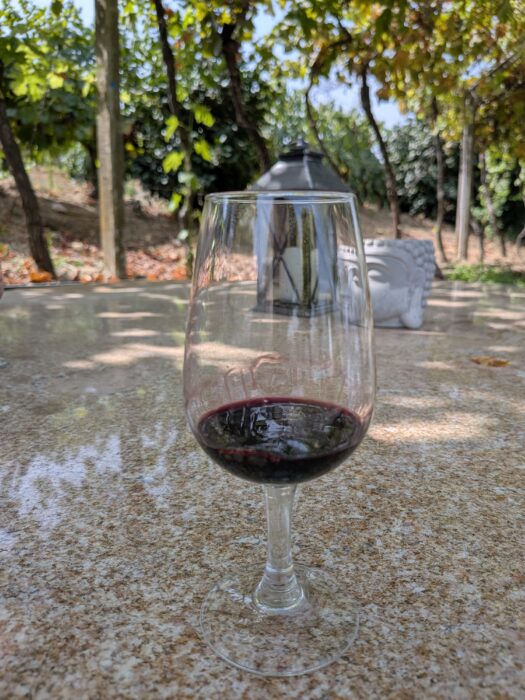
Is the Douro Valley Day Trip Worth It?
Yes. Unequivocally yes.
I am someone who researches everything and hates feeling like I overpaid for a tourist experience. The Douro Valley tour felt like genuinely good value. The scenery is stunning. The wine is excellent. The lunch is substantial. And you get to spend a full day in one of the most beautiful wine regions in Europe without dealing with any logistics.
A few caveats:
If you do not like wine, skip it. The entire day revolves around port wine. Yes, the scenery is beautiful, but you can see beautiful scenery in lots of places. If you do not enjoy wine tasting, this tour will bore you.
If you want to deeply explore the valley, one day is not enough. We drove past so many villages and viewpoints that I wanted to stop and explore. A day trip gives you a taste of the valley – literally and figuratively – but it is very structured. If you want to wander, eat at local restaurants, and stay overnight in a quinta (wine estate), book at least 2-3 days.
If you get motion sick, bring medication. The roads through the Douro Valley are winding and hilly. Several people on my tour felt nauseous. The bus driver was good about stopping when needed, but it is worth being prepared.
For me, the tour was one of the highlights of my five weeks in Porto. I would do it again. In fact, I am already planning to go back and spend a few nights in the valley next time.
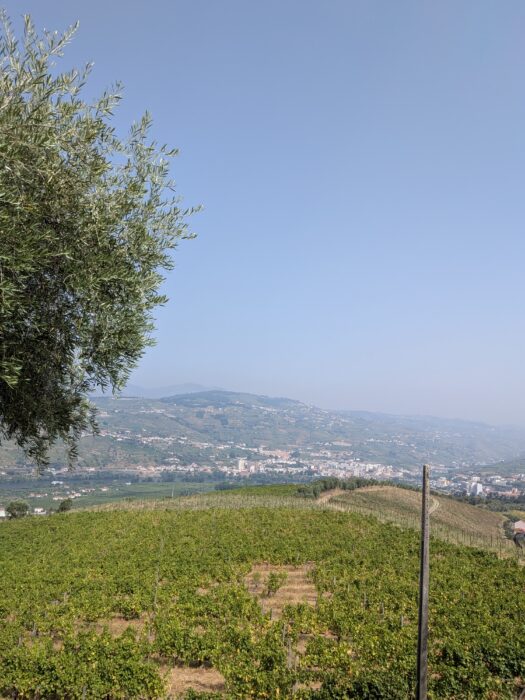
Where to Stay in Porto Before Your Douro Valley Day Trip
Most tours pick up from central Porto locations or major hotels. If you are staying in Baixa, Ribeira, or near Avenida dos Aliados, you will probably get picked up directly. If you are staying in outer neighborhoods like Bonfim or Foz, you may need to meet the tour at a central pickup point.
When I booked my accommodation in Porto, I specifically chose places near the city center for easy tour access. I stayed in four different neighborhoods over five weeks, and pickup was only an issue when I was staying in Bonfim – I had to walk 15 minutes to a pickup point near São Bento station.
Where to Stay for Douro Valley Day Trips
- The Editory Artist Baixa Porto Hotel – 120-150 euros/night
– 4.6/5 – Central Baixa location, walking distance to all pickup points, modern boutique hotel - Liiiving in Porto – Historic Clérigos Apartments – 85-110 euros/night
– 4.5/5 – Near Clérigos Tower, central pickup location, apartment-style with kitchen - Bonfim Perfect Stays – 60-85 euros/night
– 4.4/5 – Budget-friendly Bonfim location, 15-minute walk to pickup points, spacious apartments
Other Day Trips from Porto
If you have more than three days in Porto and want to explore beyond the city, there are several other day trip options:
Aveiro (1 hour by train): Known as the “Venice of Portugal” with colorful boats and canals. Good for a half-day trip. Train costs about 4 euros each way.
Guimarães (1 hour by train): Medieval town, birthplace of Portugal. Charming historic center and castle. I did not have time to visit but heard good things.
Braga (1 hour by train): Religious center of Portugal with the famous Bom Jesus do Monte sanctuary. Again, I did not make it here but it is high on my list for next time.
Coimbra (1.5 hours by train): University town between Porto and Lisbon. Beautiful library and historic center.
None of these felt as essential to me as the Douro Valley. The valley offers something you cannot experience anywhere else – those distinctive terraced vineyards and the combination of river, wine, and landscape. The other day trips are nice Portuguese towns, but you can find similar architecture and history in Porto itself.
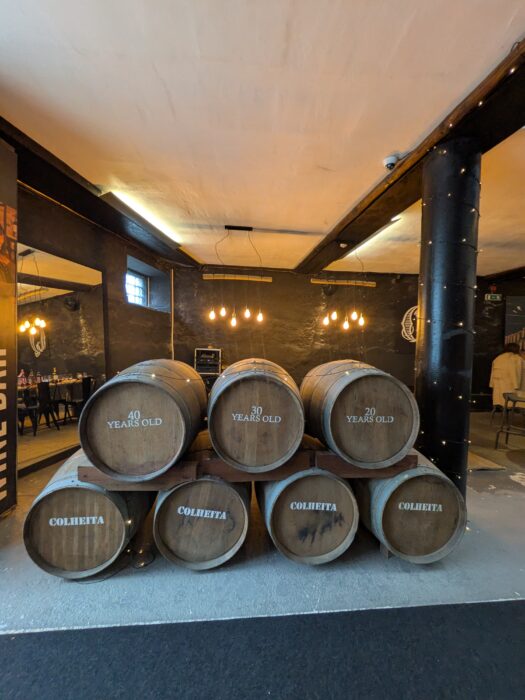
Combining the Douro Valley with Port Tasting in Porto
One thing I appreciated about visiting the Douro Valley is that it gave context to all the port tasting I did back in Porto. Before the tour, port was just sweet wine in cellars across the river in Vila Nova de Gaia. After seeing where the grapes grow and learning about the production process, the tastings in Porto became much more interesting.
If you are planning to do both a Douro Valley day trip and port house tours in Porto, I recommend doing the Douro Valley first. It will make the port cellars more meaningful when you understand the full story.
I visited Porto Cruz and Quevedo after my Douro tour, and I could actually visualize where the grapes came from and how they traveled down the river in those rabelo boats we cruised on.
Budget Breakdown: What I Actually Spent
Douro Valley Day Trip Costs:
- Tour booking (booked 3 weeks in advance): 89 euros
- Tip for guide: 5 euros
- Bottle of wine purchased at winery: 18 euros (optional)
- Coffee and snacks before 8am pickup: 4 euros
- Total: 116 euros
Everything else was included in the tour price. The lunch was substantial enough that I did not need dinner when I got back to Porto – I just had a light snack around 8pm. If you are trying to visit Porto on a budget, the Douro Valley tour is one of the more expensive activities, but I think it is worth the splurge.
Warning
Do not drink heavily the night before your Douro tour if you get motion sick. The winding roads combined with a hangover is a recipe for misery. Several people on my tour were clearly suffering from the night before, and the combination of heat, wine, and curvy roads did not help.
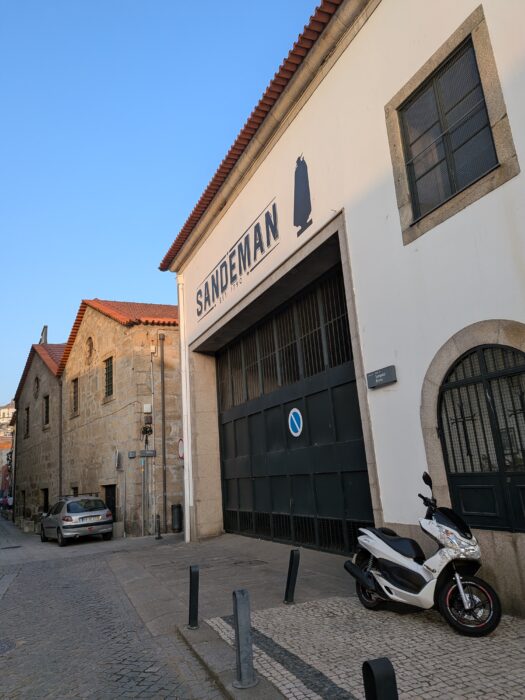
Frequently Asked Questions
How long is the drive from Porto to the Douro Valley?
About 90 minutes to 2 hours depending on which part of the valley you visit. Most tours go to the Pinhão region, which is around 100 kilometers from Porto. The drive itself is scenic once you get into the valley.
Can you do the Douro Valley without a tour?
Yes, but it is more complicated and often more expensive. You can take the train from Porto to Pinhão (about 2 hours, 12 euros each way), but then you need to arrange winery visits and transport between wineries. Most wineries require advance booking. Unless you rent a car, getting around is difficult. For most people, a tour is the easier and better value option.
How many wineries do you visit on a typical Douro Valley tour?
Usually 2-3 wineries. Some tours focus on just one or two family-owned estates with longer, more in-depth visits. Others hit three wineries with shorter tastings at each. Read the tour description carefully to see what is included.
Is the Douro Valley suitable for people who do not drink alcohol?
Honestly, not really. The entire tour revolves around wine tasting. The scenery is beautiful, and the lunch is good, but if you do not drink, you will spend a lot of time sitting around while others taste wine. There are better day trips from Porto for non-drinkers, like Aveiro or Guimarães.
What is the best month to visit the Douro Valley?
September for harvest season, or May-June for pleasant weather and fewer crowds. July-August is hot (often above 30°C) and busy with tourists. Winter (November-February) is quiet and cheaper but some smaller wineries close.
Can you buy wine at the wineries?
Yes, all the wineries we visited had wine for sale. Prices ranged from 15-50 euros per bottle. Some only accepted cash, so bring euros if you plan to buy. The wines are often cheaper at the wineries than in Porto shops, especially if you want something specific from a smaller producer.
Are Douro Valley tours suitable for children?
Most tours allow children, but it is not ideal for young kids. The tours are long (9-10 hours), involve a lot of sitting on a bus and listening to wine talk, and there is not much for children to do while adults taste wine. Teenagers might enjoy it, but I would not bring kids under 12.
Do I need to speak Portuguese?
No. All the tours I researched were conducted in English (and often Spanish and French as well). Guides are multilingual, and the wineries are used to international tourists. I speak zero Portuguese and had no issues.
Related Porto Guides
- Porto Travel Guide: 5 Weeks Living in Portugal (2025)
- 3 Days in Porto: Experience-Led Itinerary
- Where to Stay in Porto: 5 Best Neighborhoods
- Port Tasting in Porto: Which Houses to Visit
- Best Wine Bars in Porto
- Porto on a Budget: What 5 Weeks Actually Cost
- Porto in August: Weather, Costs & What to Expect
- Best Restaurants in Porto: Where Locals Eat
Last Updated: November 2025

